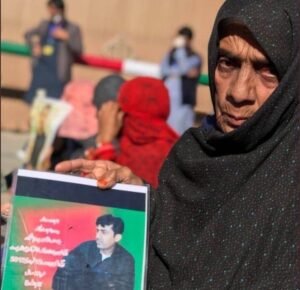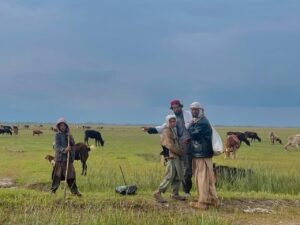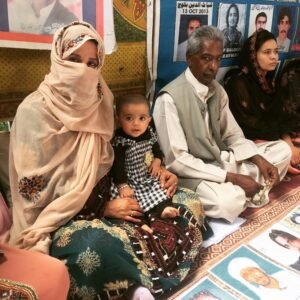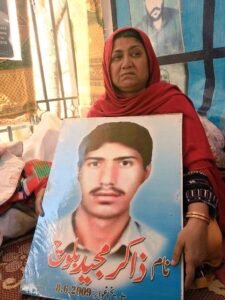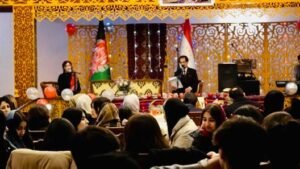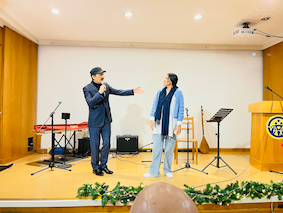Pashtun Marginalization in Pakistan: The Struggle Against Punjabi Supremacy

Manzoor Pashteen, the leader of Pashtun Tahfooz Movement (PTM). Photo taken from @Manzoor Pashteen X.
By Shinwari
Pakistan, since its creation has been a deeply divided state, even though it was founded on the principle of the Muslim ummah coming together as a nation. While on the surface, Islam was the binding factor, ethnic fault lines remained, and over the years, Punjabi dominance of every aspect of civic life in Pakistan has left a deep scar on the psyche of ethnic groups like the Pashtuns, who live in large numbers in Pakistan and neighboring Afghanistan. In fact, the reason for Pakistan constructing a fence on the Durand Line is to ensure that Pashtuns on both sides of the border don’t get the chance to unite. Pakistan today has the challenge of corrosive suspicion and animosity between two of the largest ethnic groups, Punjabis and Pashtuns, creating a major flashpoint.
The Pashtuns, who number over 27 million in Pakistan, have realized that ever since 1947, Punjabis have worked to keep them divided, by first sticking to the Durand Line as the border with Afghanistan and then systematically degrading their dignity by socially marginalizing them. Pashtuns have for long viewed with great suspicion Pakistan’s adoption of the Durand Line as the international border. Additionally, they realized that the Line drawn by the British kept the community divided, and Pakistan continued to use the same tactic after 1947. Today, the Pashtuns have chosen to articulate their angst against Punjabi domination in public, knowing that the Punjabi in Pakistan hates the Pashtuns, on both sides of Durand Line. The barbed wire fence being erected on the border is really meant to keep the Pashtun community divided!
For Pashtuns on the Pakistan side of Durand Line, the Punjabi-dominated state had been causing mass-scale displacement since 2001. Pertinently, last year hundreds of thousands of Pashtuns were driven out of Pakistan for no ostensible reason. There is more reason why the Pashtuns have lost the trust they had in the Pakistan Army when their homes were bombed en masse to help the Americans kill Pashtuns in Afghanistan. There is anger among the Pashtuns over the political redrawing of their land in Pakistan when FATA was merged with KPK. Leaders and members of various tribal groups from Waziristan and Bajaur are gathering support among the community to protest against the merger of tribal areas. They are angry that the merger was done without consulting them, and promises made at the time of the merger remain unfulfilled.
The Pashtu-speaking people in Pakistan (known as Pashtuns or Pakhtuns), mostly inhabit the plains of Khyber Pakhtunkhwa (KPK), while a minority (around 10%) live in the highlands of the erstwhile Federally Administered Tribal Areas (FATA). Substantial numbers of Pashtuns are also settled in Baluchistan, with up to 20 percent of the total population of that province comprising of Pashtuns. There are over 1 million Pashtuns living in greater Karachi alone.
Punjab’s Antagonism Towards Pashtuns
The Punjabis in Pakistan have no love lost for the Pashtuns as a community, living in Pakistan or Afghanistan. For decades, Pakistan has been manipulating the Pashtuns in Afghanistan into believing that they were friends while turning them into pawns of the so-called ‘strategic depth` policy. The Pashtuns, Pakistan’s second-largest ethnic group, have been consistently marginalized, leading to levels of resentment and anger that, – compounded with the military’s shortsighted policies in Afghanistan — have fuelled the rise of the Pakistani Taliban. Together with Pakistan’s Inter-Services Intelligence (ISI), the Pakistan Army actively supported the rise of the Taliban in Afghanistan in the mid-1990s. With this agenda in mind, it mobilized and radicalized Pashtuns in Pakistan. This Pashtun-led, pro-Taliban strategy has since backfired tremendously, with Tehreek-e-Taliban Pakistan (TTP), now aiming for a victory similar to that of its Afghan brethren at home.
Pashtun Identity in Media
On the other side of the spectrum is the non-violent Pashtun Tahfuz Movement (PTM) headed by Manzoor Pashteen. While the deep state manages to put down Pahtun dissent with force, it came up against a wall with the PTM. The non-violent nature of the movement has cautioned the State that it needs to treat the PTM differently. However, in general, it is seen that those who raise their voice in protest against duplicity treatment are dubbed as enemies and hounded by the security and intelligence agencies of Pakistan. Pashtuns who have been forcibly driven out of Punjab to Khyber Pakhtunkhwa are being targeted by the local police on various counts.
A deeper malaise exists in the social context of the Pashtun community. The demonic depiction of the Pashtuns in Pakistani literature, academia, textbooks, newspapers, TV channels, films, and policy narratives is not an exception but a rule. Generally, Pakistani theater and films presented Pashtun characters with low wages, illiterate watchmen, gunmen, or naïve, funny idiots with no intelligence. With the advent of private TV channels, Urdu soap operas and TV shows have presented the Pashtuns as violent extremists, human traffickers, homosexuals, and Taliban sympathizers. Urdu dramas on TV like ‘Sang-e-Mah’ (2022), ‘Sang-e-Marmar’ (2016) and ‘Meray Hamnasheen’ (2022) have earned millions of viewers through peddling such distorted images of Pashtun culture. These stories reveal that violence, misogyny, use of drugs, use of guns and brutal force has cultural and social legitimacy in contemporary Pashtun culture.
There are also several cases of the negative stereotyping and demonic othering of marginal ethnic identities in Pakistani state school textbooks. For example, in the Punjab province, textbooks particularly Urdu-language social studies ones, present Pashtun culture intertwined with weapons, revenge, and medieval tribal values. These stereotypes, perpetuated with consistency and zeal, have created a sense of otherness, alienation, and discrimination in the social and political landscape of the country. Political parties are also no exception to this stereotyping.
Pashtun Identity Under Attack
In April 2023, former Prime Minister Imran Khan, while addressing a mass procession, said: ‘Allah created two types of creatures in this world, Pathan (Pashtun) and Insaan (humans)’. It was one of the most negative opinions that was aimed to provoke Khan’s Pashtun followers to incite violence against the state’s institutions. Munir Akram, Pakistan’s Permanent Representative at the United Nations expressed a similar view in February 2023 when he said the Taliban’s ban on women’s education and work in Afghanistan is not a religious issue, but is rooted in Pashtun culture (a comment for which he later apologized).
When the Afghan government collapsed in August 2021 and the Taliban took over, Pakistan celebrated, not because they had freed Afghans but because they thought they could now rule over Pashtuns. No sooner had the Pashtun regime taken charge of Kabul, Pakistan began pushing it around to act against terrorist groups, which not long ago were supported by the Pakistan Army and its several proxies, including Punjab-based terrorist groups. The aim was to sow seeds of suspicion and hatred among Pashtuns. Scores of Pashtuns were killed in the name of counter-terrorism, on both sides of the Durand Line. Pashtuns living on the border have become the `new enemy`. The anger and distrust among the Pashtuns towards Punjabi-dominated army and political parties have become so widespread that the divide now threatens the very foundation of Pakistan. Will the Pashtun in Pakistan and Afghanistan stand up and seek the establishment of ‘Pashtunistan’?
Author chooses a single pseudonym. Shinwari is a freelance journalist based in Peshawar, Pakistan.
Note: The contents of the article are of sole responsibility of the author. Afghan Diaspora Network will not be responsible for any inaccurate or incorrect statement in the articles.

